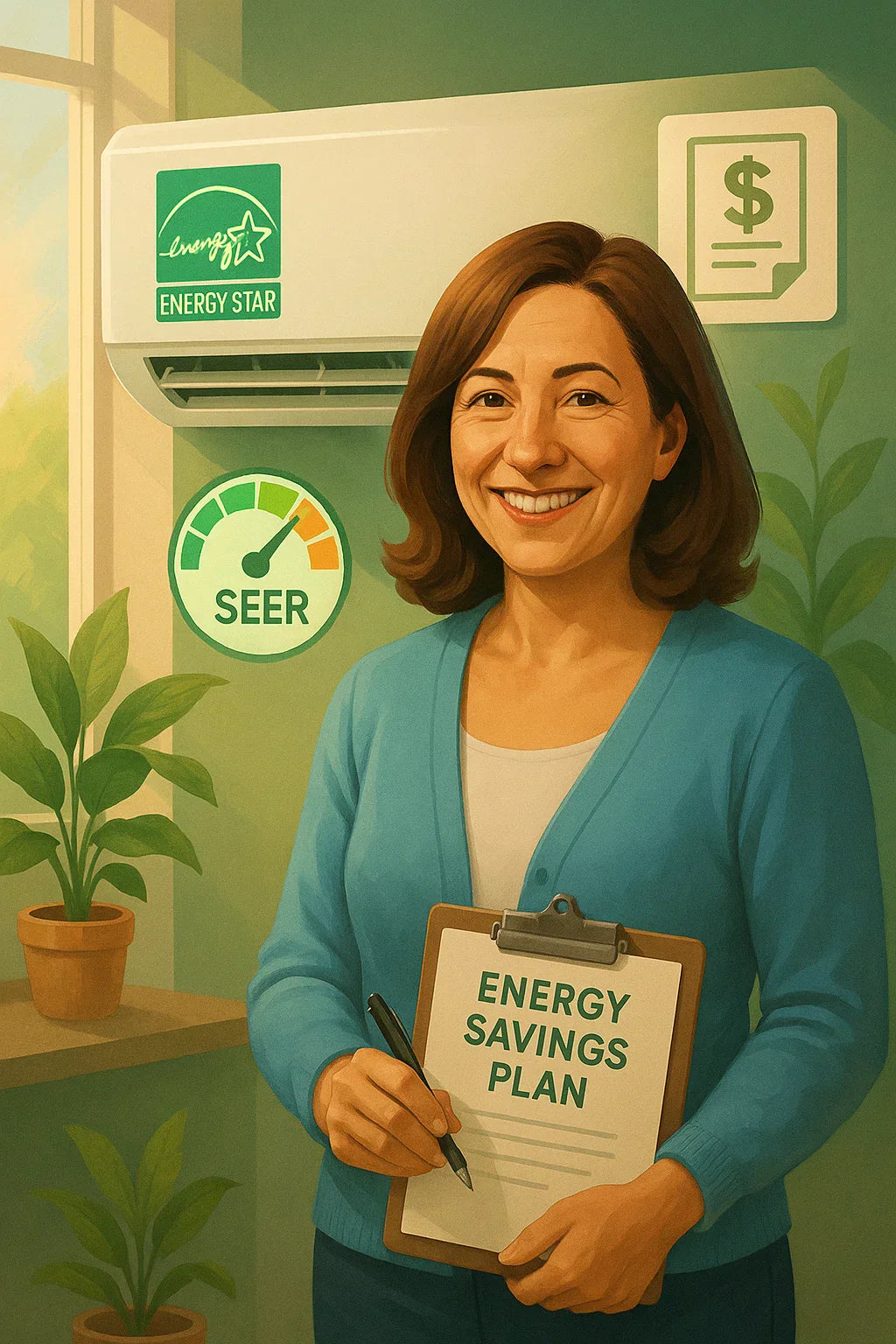💡 Why Samantha Needs to Know About Efficiency and Tax Credits
Investing in a ductless mini-split system offers more than just comfort; it can also bring Samantha substantial energy savings and tax benefits. Understanding how efficiency ratings impact energy use, what rebates and credits are available, and how to claim them can help Samantha:
✅ Lower upfront costs
✅ Reduce monthly energy bills
✅ Increase long-term ROI
✅ Support environmental sustainability
⚡ Understanding SEER and HSPF Ratings
SEER (Seasonal Energy Efficiency Ratio) measures cooling efficiency. The higher the SEER, the more efficient the system. Modern ductless mini-splits often range from 19-30+ SEER.
HSPF (Heating Seasonal Performance Factor) measures heating efficiency. Higher HSPF indicates better heating performance, with many mini-splits offering 9-12+ HSPF.
✅ High SEER and HSPF ratings mean lower electricity consumption and cost savings. ✅ Systems with higher ratings often qualify for federal tax credits and utility rebates.
⭐ ENERGY STAR Certification and Ductless Mini-Splits
ENERGY STAR-certified mini-splits: ✅ Meet strict efficiency guidelines set by the U.S. EPA. ✅ Are up to 30% more efficient than non-certified systems. ✅ Reduce greenhouse gas emissions. ✅ Typically qualify for federal and state rebate programs.
Check the ENERGY STAR ductless mini-split guide here.
🏛️ Federal Tax Credits for Ductless Mini-Splits (2025)
Under the Inflation Reduction Act, homeowners may qualify for: ✅ Up to 30% of the total system cost (equipment + installation), with caps depending on system type and efficiency. ✅ Credits applicable to both primary residences and certain secondary properties. ✅ Higher credits for heat pump mini-splits that meet ENERGY STAR requirements.
Example: If Samantha installs a $12,000 multi-zone mini-split system:
-
30% potential credit = $3,600 in federal tax credits.
-
Effective net cost: $8,400 before additional rebates.
Read the IRS guidance on residential energy credits here.
🗺️ State and Utility Rebates
Many states and local utilities offer additional incentives, including: ✅ Cash rebates ($200 - $1,500+) depending on system SEER and HSPF. ✅ Low-interest financing for energy-efficient HVAC upgrades. ✅ Bonus rebates for income-qualified homeowners in certain states.
Example programs:
-
Mass Save (Massachusetts)
-
NYSERDA (New York)
-
PG&E (California)
-
Xcel Energy (Midwest)
Samantha can find eligible programs using DSIRE.
📊 Example Savings Calculation
If Samantha purchases a $10,000 ductless mini-split system:
-
Federal tax credit: $3,000 (30%)
-
Local utility rebate: $800
-
Net cost after incentives: $6,200
-
Estimated annual energy savings: $500 - $800/year
In this example, Samantha’s system would pay for itself in energy savings and rebates within 7-10 years while providing comfort and efficiency.
📝 Eligibility Requirements
To qualify for tax credits and rebates: ✅ The system must meet ENERGY STAR or local program efficiency standards. ✅ Installed in a primary residence (exceptions may apply). ✅ Installed by a licensed contractor with appropriate documentation. ✅ Proof of purchase, SEER/HSPF ratings, and installation invoice required for claims.
🛠️ How Samantha Can Claim Tax Credits and Rebates
✅ Step 1: Research federal, state, and local programs using DSIRE and ENERGY STAR.
✅ Step 2: Confirm chosen mini-split system qualifies for incentives.
✅ Step 3: Have the system installed by a licensed HVAC contractor.
✅ Step 4: Collect invoices, SEER/HSPF documentation, and rebate forms.
✅ Step 5: File IRS Form 5695 for federal tax credits during tax season.
✅ Step 6: Submit rebate applications to local utilities promptly.
View Form 5695 instructions here.
🧩 Choosing the Right Mini-Split for Maximum Incentives
✅ Look for ENERGY STAR-certified systems. ✅ Prioritize high SEER and HSPF ratings (even if the upfront cost is slightly higher). ✅ Choose systems with inverter-driven compressors for maximum efficiency. ✅ Consider heat pump mini-splits for year-round comfort and higher incentives.
These decisions ensure Samantha qualifies for maximum rebates while reducing long-term energy bills.
🌎 Environmental Impact and Sustainability
By choosing a high-efficiency ductless mini-split system, Samantha will: ✅ Lower her home’s carbon footprint. ✅ Reduce electricity usage and grid demand. ✅ Support global emissions reduction efforts. ✅ Improve her home’s resale value through energy-efficient upgrades.
✅ Conclusion: Samantha’s Action Plan
1️⃣ Research available rebates and tax credits. 2️⃣ Choose an ENERGY STAR-certified, high-SEER mini-split system. 3️⃣ Work with a licensed contractor for installation. 4️⃣ File for rebates and tax credits to maximize savings. 5️⃣ Track energy savings to monitor ROI.
Ductless mini-splits do more than keep your home comfortable—they can significantly lower your costs while supporting your sustainability goals.
📲 Ready to Shop Efficient Ductless Mini-Splits?
Explore our Ductless Mini-Splits Collection to find ENERGY STAR-certified systems that qualify for tax credits and rebates while maximizing your comfort and efficiency.
In the next topic we will read more about: Can You DIY a Ductless Mini-Split Installation? What Homeowners Should Know







